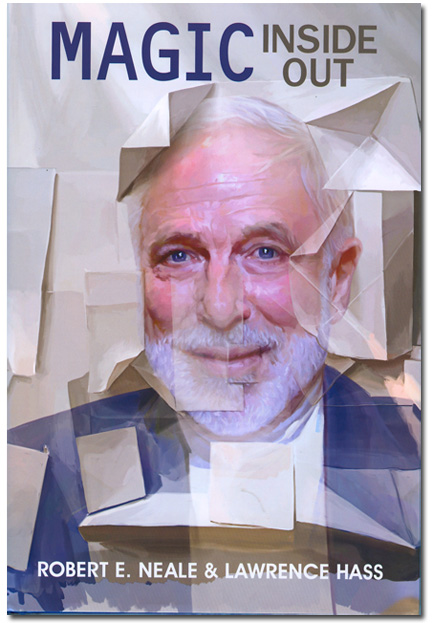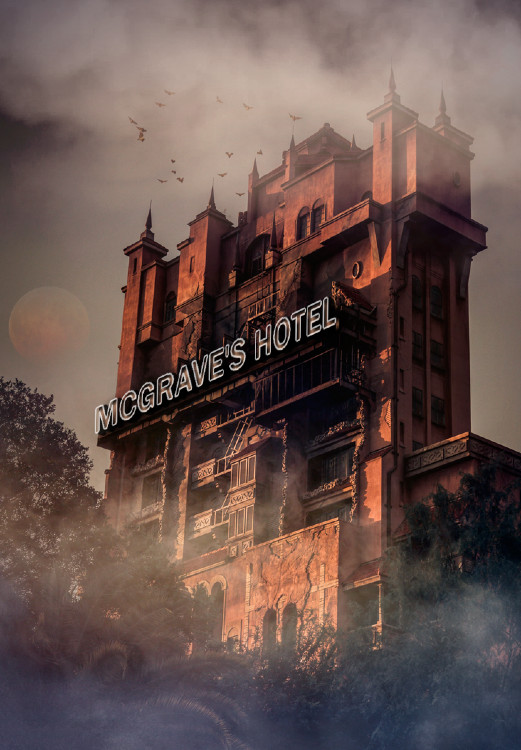
When it comes to magic books, January is not at all what I expected. Mr. Jennings is at the bottom of the south China Sea. Steve Cohen's Confronting Magic is almost here, but not quite. There is a clean spot for it on my coffee table. A signed Kreskin graphic novel is in the mail. Maybe tomorrow. Fortunately, two surprise volumes arrived to fill the void: Magic Inside Out by Robert E. Neale and Larry Hass, and unconventional.book (that's really the title!) from the Toronto Magic Company. (Amid this information was the news that Larry Hass has completed the writing of the next Eugene Burger book. Yay!)
MYSTERIES UNFOLDED -- The surprise purchase this month was Magic Inside Out,from Theory and Art of Magic Press. The title, which has several meanings, is of course a reference to Bob Neale’s penchant for topological trickery. (The first Neale effect I ever purchased was Bunny Bill.) Given that two of my longtime favorite card tricks are hidden in Life, Death & Other Card Tricks, the new volume is a welcome addition.
Magic Inside Out is a crazily eclectic collection of 14 performance items plus a lengthy interview with Mr. Neale.
To mention a few …
You Can Tell by the Smell is a creepy bizarre trick (it first appeared in the 666 issue of Genii) that, like favorites from my magical childhood, will send me back to my neighborhood pharmacy to purchase chemicals. Will they still sell you the stuff that appeared in those old books?
Fortune telling is the basis for several routines. Just Imagine is a fortune telling deck you can easily make yourself or purchase separately. Journey with the Joker is a prediction that always works, and Quickie fortune impresses thanks to the plunger principle.
Folding and combining exploit Neale’s genius for such themes. Dream Door and The Possibility of Paradise are further presentations for the Trapdoor effect. Rings of Relationship feature three flat rings that are inexplicably combined yet each floats freely above or below the other two. Banded Dollar Bill is a fold that lets a dollar encase a packet of cards.
And then we come to items that are the highlights of the book, yet both Larry Hass and I consider ourselves too squeamish to perform. A few (Odd Couples, Attraction) seem dated (?) because the gender make-ups of couples or indeed individuals have become blurred in recent times. Older binary labels no longer suffice. Vietnam Zippo is a prediction using lighters that evokes harsh G.I. adages from the Vietnam era. I’d have a hard time finding an appropriate venue or audience. Or for this one: The Story of Private Underpants! This requires the magician to slip a pair of underpants (briefs) onto the arms of his assisting spectator and to turn them inside out even though the spectator has locked them in place. Both the visuals and the storyline are a trip. (Those familiar with the Captain Underpants books have an advantage.) And finally, The Nun Who Saw Strangely. Bob Neale is dyslexic, and that handicap is exploited when an imperfect magic square becomes perfect if viewed outside, high in a chapel, when some nuns “turn their backs to the chapel, spread their legs apart, lift their skirts high, bend over, and look at the digits through their legs.” Need I add that some bawdy wordplay comes to bear on the situation? Interesting magic trick! I’d love to have seen Eugene tackle this one.
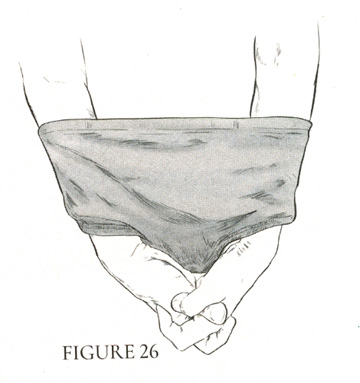
The magic is all Robert E. Neale, and the organization is Larry Hass. Larry introduces and establishes the context of each routine, adding remarks in the text as required. The book closes with a 39-page interview of Bob by Larry. Much is covered, including but not limited to how Bob organizes his hundreds of creations, favorite items in this book, his Shadow Digest collaboration with Shane Causer and Larry White, the dyslexia, Freud, his 24-year career as professor of religion and psychiatry, leaving that career, Jeff McBride’s Mystery School, his intro to magic (Harlan Tarbell—the man, not the encyclopedia), Ormond McGill, and when to be Bob, Robert E., or other variants.
Hardback with dust jacket, 160 pp, foreword by Lawrence Hass, with Selected Bibliography, About the Authors, and About Theory and Art of Magic Press. $34.95 from Theory and Art of Magic Press.
VIRTUAL CONVENTION SWAG -- Back in October 2020 I reported on Ben Train’s and Jonah Babit’s unconventional, a magic convention inside a video game. I closed the piece with "A package of lecture notes and other goodies is coming in the mail." Said swag has arrived and I am happy to comment on the "lecture notes," a 120-page softbound, glossy-paged gem of a book, titled unconventional.book. The contributors alone constitute (to me) a who’s who and who’s new in magic: Jonah Babins, Chris Mayhew, Jackie Swan, Ben Train, Glenn West, Michael Feldman, Curtis Kam, Caleb Wiles, David Parr, James Alan, Phil Pivnick, Ben Seidman, Felice Ling, Carisa Hendrix, and Harrison Greenbaum. Content played out in three sections: Cards, Props (non-card magic), and Thots (essays on various topics). It was consistently refreshing, and I don’t recall enjoying convention "lecture notes" this much since Spectacle (Minch, 1992).

A few cases in point:
Caleb’s Cross-Eyed Triumph is a dazzling production of any named four of a kind that segues immediately into a convincing Triumph. You could perform either half on its own, but the combo is temptingly efficient.
Curtis Kam’s Choices is the coolest extrapolation I have seen of Steinmeyer’s 9-Card Deal. Self-working and intriguing.
I favored the additional card stuff over the prop stuff because of personal inclinations, but could not ignore Ben Seidman’s Vanish, the vanish of a half dollar into your eye! A creepy effect with a kinda creepy method, but it would be fun to watch.
"No Matter Where You Go There You Are" is Curtis’s essay on types of material to perform online, with numerous specific examples.
Tim Hanning’s "Be Present" is the longest essay, on how to be in the moment despite constant repetition of your act.
In Harrison’s "You Are All Terrible … at Virtual Shows," he explains some of the difficulties transitioning your live stuff to Zoom stuff.
And then "The Bugs Bunny Theory," Carisa Hendrix’s essay on how (and why) to create an antagonist in your show. This immediately enhanced several of my favorite routines. She is such a smartie.
To sum up, the book was a welcome surprise, with 19 titled items plus a foreword and intro from Ben and Jonah. I have no idea if any are left, but you might inquire at the Toronto Magic Company Store.

New options and continuing excellence characterize a wealth of available online magic. David Williamson has launched The Magic Dave Show (30 minutes of magic every two weeks) as a subscription service from Penguin. The Magic Castle posted its Founders' Day celebration online for the first time ever. The Castle also continues its twice-weekly Behind the Bookcase along with Saturday night Dine and Delight shows plus occasional kid shows, lectures, and a large store of on demand material. (Although I don't usually comment on magic shows or lectures, I must say that I was quite taken by a recent well-attended lecture from Bruce Kalver. It contained some terrific practical ideas, and I loved seeing him perform his portable Pepper's Ghost illusion.)
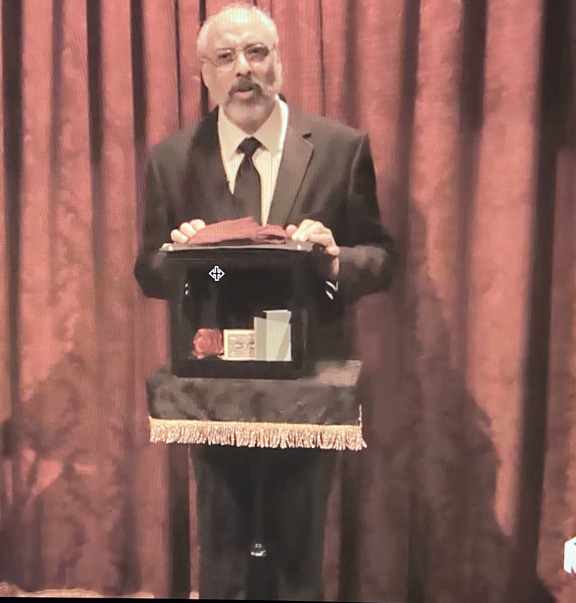
David Sandy's Collectors Corner posts are on hiatus, but we hope they return soon, and Harrison Greenbaum still posts the occasional interview. Much to love!
MAGIC DAVE IS HERE -- The first installment of The Magic Dave Show is free and fabulous. What David Williamson and Penguin propose is 30 minutes every two weeks in which Dave will answer questions, teach a trick, and interview friends. For me the gold n the first three episodes is the trick segment, first with variations on Nick Trost's Eight-Card Brainwave, then with a card transposition cleverly cast as Metamorphosis, and Knife in the Water (a paddle move trick). (In the third installment, Dave also teaches his work on the DPS.)
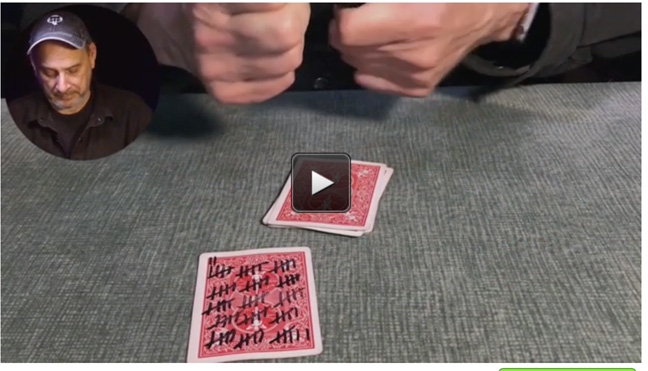
Your cost is five bucks an episode. The catch is that it's a subscription. If you subscribe today, you get the next episode. So subscribe early! (Your credit card is hit only 10 bucks at a time, so you don't have to pay a big subscription fee up front.) Your issues then appear like standard Penguin downloads. I was extremely pleased with the quality of the first two tricks taught. I also like the idea that they Interviewees for the first three episodes were Ben Earl, John Carney, and Shoot Ogawa.
IN THE BEGINNING -- Fifty-eight years ago, on January 2, a couple of magic-obsessed brothers and one of their girlfriends (Bill, Milt, and Irene) launched a Magic Castle as the clubhouse to their father’s Academy of Magical Arts, and magic changed forever. Although the event has been honored by a Founders’ Day celebration every January 2, I had never attended because of my geographical isolation. Until this year! The current powers that be held the celebration online, and hundreds were able to partake. What fun.
The festivities opened with a cocktail hour hosted by Lucy Darling (who else to raise cocktails?). Events transpired quickly: Guys in hazmat suits sanitized the Magic Castle. (Thanks to Robert Ramirez for this video.) Puddles Pity Party sang Happy Birthday. Goldfinger and Dove wished all a Happy Founders’ Day.
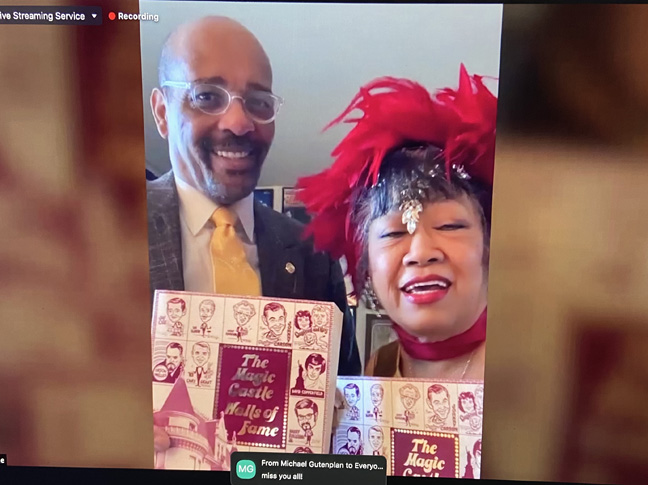
Lucy performed an audience interactive Mixology routine. Bonnie Gordon sang “My Heart Belongs to Miltie” as many nostalgic photos flowed past. Milt himself talked of the first night party, with six attendees occupying the six stools at the bar.

A video of the Palace of Mystery construction played to Trini Lopez’s “If I Had a Hammer.” Johnny Thompson spoke of his early visits, though he did not perform at the Castle until 1976. John Carney caused cards to rise from a glass, four cards bearing the images of Jay Ose, Dai Vernon, Charlie Miller, and Francis Carlyle. Erika Larsen (the real host of both hours of this party) joined with Lucy for a game in which prizes were awarded. (Love to have won those Owen linking rings used by Erika’s grandfather! Meanwhile, congrats to my friend John Signa for winning a copy of The Magic Castle Walls of Fame. ) Zabrecky performed a brief séance. And Liberty Larsen sang “Blowin’ in the Wind.”
We all then logged out of that Zoom site and into another to watch Max Maven host an excellent show. Rabby Yang manipulated golf balls in and out of a case and of existence, very nice. Larry Wilmore fooled me with balanced—then levitated—cards.
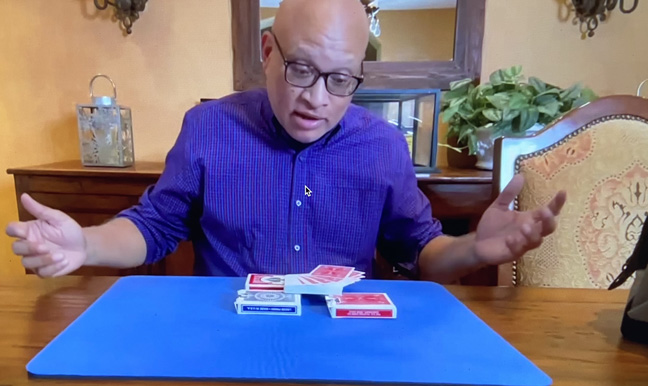
Dani DaOrtiz fooled me (as he always does) and some Spanish buddies producing any four of a kind from a multiply shuffled deck. Ice McDonald performed a rope trick that concluded with a dove production. What? And followed by a cameo from Lucy Darling’s cat, Goosey. Ben Hart entertained with an illusion-scale dramatic rendition of Snowstorm in China (but definitely not in China). Malin Nilsson followed with a four-Chinese-ring (but hardly Chinese) and top hat routine though I wish it had been her quite different routine that would soon fool me, Penn, and Teller. MonDre worked with silks, flowers, and liquid; I’ve been a fan from back when he was Michael Douglas. D’Lite-ful. Max himself is the king of audience participation routines on television, and he proved it again via a touch-a-screen item (after carefully instructing participants not to actually touch some screens). Peter Stickles and Michael Carbonaro swallowed some needles. Topas and Roxanne produced a zillion people from behind a light screen. And Eric Chien fooled and delighted me with a signed card to plastic frame that I wish he were selling.
All in all, it was two fast hours of fun people and fine magic. Thanks, Milt, for kicking this off 58 years ago. It has made all the difference.
RETURN TO BEHIND THE BOOKCASE – I was badly fooled Sunday 12/13 by Horret Wu. His jumbo card routine, in which jumbo cards dealt to the table assumed normal proportions, looked like trick photography. An appreciative Shoot Ogawa hosted.

John Carney introduced the Fitzgerald Who’s Hoo interview with Jim Steinmeyer 12/17. The meeting focused on Jim’s book, The Last Greatest Magician in the World: Howard Thurston. Thurston had a most interesting and harrowing childhood outside the law, all new to me.
All the Behind the Bookcases have been great, but some are special. So it was Sunday 12/20, with a two-hour-plus taped interview of Harry Lorayne by David Regal. David was on hand with Jonathan Levit to introduce the recording, which they broke into six segments. I’ve been reading Harry Lorayne steadily since Close-up Card Magic in 1962, including his autobiography Before I Forget, but still found much to surprise. There were new stories and new details on old stories. I keep notes when I listen to these and placed a star beside over a dozen significant new Harry Lorayne facts. What a nice life Harry has made, and continues to make, out of card tricks, a crack memory, and conversational writing that is unequaled.
Just when I thought Behind the Bookcase couldn’t be more special, along comes Rob Zabrecky with an informed history of the midnight spook show era. Sunday December 27 Zabrecky expanded on the tales in Mark Walker’s Ghostmasters with inside info on the shows of John Daniel (his premiere assistant and wife would become Irene Larsen, and his second wife Kathy would provide additional info) and the spook show’s descendents, from late night television “ghost hosts” (Zacherle, Vampira, Elvira) to Roger Corman movies of the sixties to Zabrecky’s own spook shows at Brookledge. (If only those had been recorded!) John Carney hosted and reminded us of the spooky routine contributed by actor Jimmy Stewart to The Jinx! (Check issue number 57.)

OK, can you top Harry Lorayne and Zabrecky? You can try, as Chris Hart did Sunday 1/3 with guest Carisa Hendrix, aka Lucy Darling, Max, Dee Dee, and more. Carisa was her usual open and brilliant self, sharing a painful breakup with her family and taking Chris through her extensive performing careeer, beginning at age 16. A highlight was her “Fool Us” appearance, which didn’t fool brainiac Teller, but fooled me badly. The solution is in her Penguin lecture.
The seventieth edition of Behind the Bookcase was an encore presentation of the first, with a tour of Egyptian Hall Museum by Mike Caveney. This is a fascinating working collection. I watched it twice more. Mystery question: why were 50 blank copies of Greater Magic printed?
The seventy-first edition (Sunday 1/10) was John Carney’s Dream Show in the Palace, with biographical notes from John on his stellar performers: Slydini with his Paper Balls Over the Head, Al Koran on the Sullivan show, Blackstone and his borrowed Dancing Hank, Dick Van Dyke (and Tina Lenert) as The Great Roboto and company, Hans Moretti in a cardboard box pierced by 16 sharp swords, and Omar Pasha and his black art act. All were swell, but of them I have no clue how Moretti survives his magical penetrations. What a magic show!
Thursday 1/14 was a eprise of Behind the Bookcase with Suzanne. Is she the only magician we know who owns a horse? (No! To answer my own question, Melinda used to use one in her show. As of course did S&R.)
Perhaps the most geographically distant interview came Sunday 1/17, as Shoot Ogawa in Japan interviewed Javi Benitez in Spain. A “Fool Us” winner praised by Penn as the best sleight-of-hand artist on their show, Javi proved to be not only highly skilled, warm and funny , but a deep thinker about magic as well. His remarks also enhanced our opinions about his mentor, Ascanio, who tutored him in philosophy and poetry as well as magic.
RETURN TO WHO BOOKS THAT? – Harrison Greenbaum wrapped his year of Who Books That? with an interview with Chris Williams, an actor (“Curb Your Enthusiasm” and much more), magician, and younger brother of Vanessa Williams. The surprise guest was Eric Jones. The most heartwarming bit was Chris’s realization, as someone a little late to magic, at how diverse the spectrum is of what constitutes “a magician.” Most surprising fact (even to Harrison): Chris went to high school with Steve Cohen.


ALOHA TO GIANTS– Way back in the infant days of the internet, I debated whether to attempt a web site about magic or about movies. In those days I saw every movie that came out. Had I chosen movies, at least I wouldn’t have felt compelled to write obituaries about favorite magicians. Had I chosen movies, I would say that I saw very few in this pandemic year, but my choice for favorite is easy: The Vast of Night. It’s a lovely instance of old-fashioned sci-fi. Try to find it.
But I chose magic …
We lost four giants since last getting together: Al Cohen, David Roth, Siegfried, and Mark Wilson. Each had his niche, and each was the best there was at what he did. Al Cohen was simply the best demonstrator ever. You couldn’t wait to get the same happy reactions he was getting. My favorite of the tricks I bought from him was a gadget for naming the value of any card held in front of me, but so that I could see only its back. The dastardly secret was a small mirror that extended from the bottom of a card box lying on the table, the ultimate shiner. If you held the card just right, its reflection conveyed its identity. He was a purveyor to Presidents. To note his passing, the Washington Post devoted five columns and a couple of large photos to him.
David Roth was, to coins, the graduate school you attended after Bobo. I fondly recall his saying, after performing his Purse and Glass in a lecture, “If you liked the effect, you’re going to love the method.” And we did, thanks to some sneaky audio deception.
And then there was Siegfried Fischbacher, who with his partner Roy Horn earned the right, like Elvis, to be known by their first names only, and sometimes only by their initial, S&R. It was one of the great collaborations in show business, Siegfried and Roy plus their Leading Lady Lynette Chappell and an extensive menagerie of animals distinguished by those oversized white tigers. No magic show had ever existed at that rock star scale. I was lucky to see the guys in person many times, from their stint in Hallelujah Hollywood at the MGM to their long run at the Mirage. The scale and the animals took my breath away, virtually all of the illusions seriously fooled me, and their Smothers Brothers repartee entertained me. I do hope that recorded footage of the show exists, perhaps for imax, and that this brilliant instance of magic and showbiz will shine on.
And who doesn't revere Mark Wilson? For us old guys, and the baby boomers on our heels, Mark Wilson defined "magician," especially on television. Check out the family web site at markwilsonmagic.com. I watch his youthful energy and I am a kid again. Allakazam!

Aloha, guys. You were magical.

